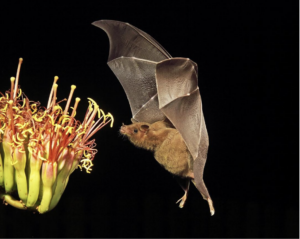Going Batty
There are 33 bat species in Texas, representing one of the most diverse bat populations in the U.S. Texas bats consume some mosquitoes, but their diets consist primarily of moths and beetles. This diet plays a large role in controlling insect pests in agriculture. Most people associate pollination with bees and birds but often forget the work of their furry colleagues: bats. Bats take the night shift, playing a major role in pollinating crops and spreading seeds. The seeds and fruits that compose part of our diet would not exist without the interaction between flowering plants and pollinators, including bats. Bats feed on flowers, including those of valuable commercial crops, like figs, dates, mangoes and peaches, which have flowers that only open at night.
Bat populations are dramatically declining in part due to habitat loss. You can help by providing native plants that will be a food source for the insects that bats are actually eating. They tend to enjoy a flower that’s mild in scent and not too bright in color. Many of these are the same pollinator plants which you already know: purple coneflower, goldenrod, yarrow and salvia. You can also help by installing bat condo structures where the furry friends can make a home.
Learn more in these articles: Working the Night Shift and Creating a Garden for Bats
